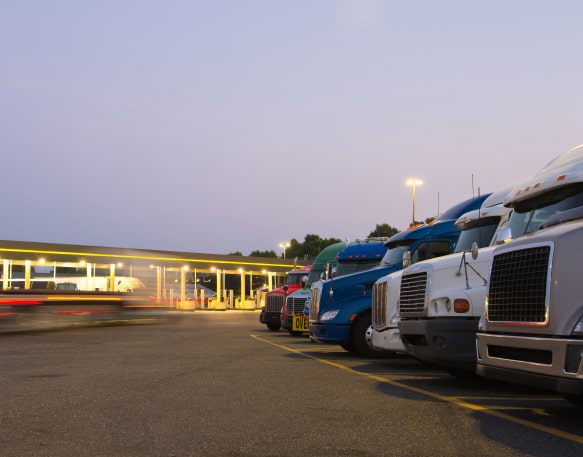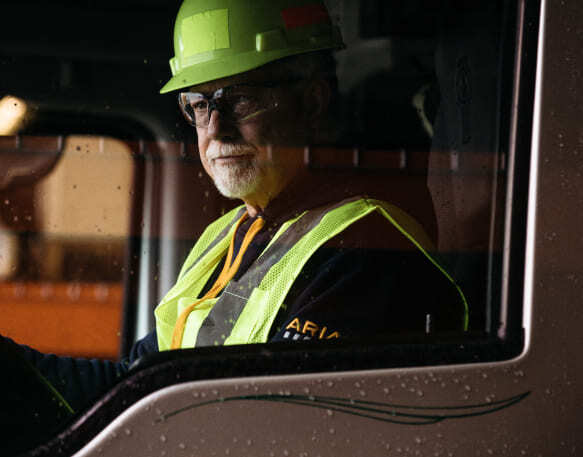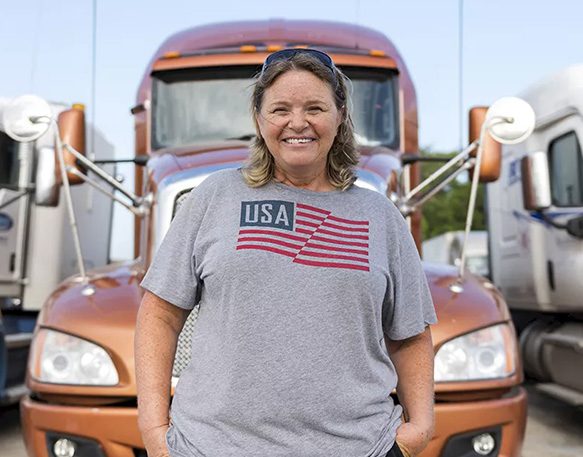Both carriers and owner-operators have struggled with the distinction between logged moves and personal conveyance since the implementation of the electronic logging device (ELD) mandate and the accompanying Hours of Service (HOS) rules.
Read on to better understand the definition and limitations of personal conveyance, who must comply with the regulations, and how to optimize ELDs to avoid violations.
What is personal conveyance in trucking?
The Federal Motor Carrier Safety Administration (FMCSA) defines personal conveyance as “the movement of a commercial motor vehicle (CMV) for personal use while off-duty.” In essence, this is any activity a driver engages with a CMV while off-duty and relieved of their responsibilities as a motor vehicle carrier.
Unlike other vehicle statutes, which are handled by the Department of Transportation (DOT), personal conveyance guidelines are established and defined by the FMCSA for specific use by drivers and motor carriers as a reference in determining their own policies. The FMCSA’s personal conveyance guidelines do not restrict motor carriers from establishing different or more restrictive personal conveyance guidelines. It also doesn’t require motor carriers to provide a personal conveyance policy.
Proper (and improper) uses of personal conveyance
Determining which activities fall under personal conveyance and which do not is ultimately up to the motor carrier’s policy. Though they must fall within the guidance of the FMCSA’s established guidelines, motor carriers can establish more restrictive standards that prevent the movement of a CMV outside of operational activities. Providing personal conveyance rules is allowed under the law but isn’t required for motor carriers to outline.
Operating a CMV under personal conveyance doesn’t reduce or revoke the driver’s responsibility to operate a CMV safely and responsibly.
Some examples of proper use of personal conveyance include, but are not limited to:
- Operating a CMV to travel between a driver’s lodging (i.e., a motel, truck stop, or rest area) to restaurants or entertainment facilities.
- Commuting between a driver’s primary residence and the terminal (and visa versa)
- Commuting from a driver’s primary residence or terminal and their next work site or trailer drop.
- Note: Under these circumstances, the driver must be allowed proper time to obtain restorative rest, and therefore, the commuting distance and time after release from work/start of next shift must be taken into consideration.
- Time spent traveling to the first safe, nearby, and reasonable destination to obtain restorative rest before resuming on-duty work.
- Time and distance accrued moving or relocating a CMV at the direction of a safety official during a driver’s off-hours period.
- A driver may claim personal conveyance if they are operating a passenger-free motorcoach en route to a restaurant or entertainment facility and their lodging, given their lodging is the first nearby, safe, and reasonable site and they are off-duty.
- Note: Personal conveyance can also be applied in this situation if other off-duty drivers were present as passengers in the motorcoach.
- Time accrued transporting personal property in a CMV while considered off-duty.
- Previously authorized use of a CMV to travel to the driver’s primary residence after working offsite.
Instances where personal conveyance rules may not be applied include:
- Moving a CMV to a more lucrative resting location between loads, forgoing a nearby, safe, and reasonable resting area (i.e., shortening the distance between a drop-off and the next pickup during off-hours at the expense of restorative rest).
- Returning to the point of origin under the direction of a motor carrier after dropping off a towing unit to retrieve another towed unit.
- Continuing a CMV trip with an empty load with the intention of fulfilling a business purpose (i.e., picking up another load) at the direction of a motor carrier.
- Repositioning a CMV at the direction of a motor carrier.
- Time and distance spent carrying passengers in a passenger-bearing CMV.
- Transporting a CMV for vehicle maintenance or repair.
- Time spent traveling to a nearby, safe, and reasonable destination for restorative rest after being placed out of service under part 395 or at the direction of an enforcement officer.
- Traveling to a carrier terminal after unloading or loading a CMV from a shipper or receiver.
- Time spent operating a motorcoach laden with luggage after passengers have disembarked with the intention of delivering stowed luggage to a different destination.
The importance of having a motor carrier policy in place for personal conveyance
Personal conveyance rules protect both the driver and the carrier in multiple ways. The FMCSA encourages motor carriers to adopt personal conveyance policies in order to provide guidelines for drivers operating CMVs. These guidelines fall within Hours of Service (HOS) regulations, and compliance with these guidelines will keep drivers and motor carriers within the boundaries of the law.
Establishing these policies and providing detailed training, documentation, and examples to drivers will help reduce the chances of falling afoul of HOS regulations, which can result in fines, sanctions, and other penalties.
Consider establishing reasonable limits on personal conveyance mileage. Rather than setting an arbitrary number, consult with your drivers and safety staff to determine a reasonable amount of distance allowable under your personal conveyance policy.
Furthermore, consulting with your insurance carrier’s safety and compliance team will help shape your organization’s personal conveyance policy. The main objective should be the public and drivers’ safety. After all, a limit on personal conveyance that runs afoul of safety guidelines is more difficult to defend against a claim than a policy that is accommodating to allowing a driver to obtain restorative rest.
Determining if you’re using personal conveyance
Especially common with newer drivers is the question, “Can I use personal conveyance to drive home?” The easy answer is yes! However, many companies may apply a more restrictive policy on personal conveyance. Be sure to consult your company policy before determining personal conveyance to and from your primary residence.
An easy way to gauge whether or not you should consider yourself under the scope of personal conveyance is to ask yourself: “Is this trip related to work?” If the answer is yes, chances are you can’t consider the time and distance traveled as personal conveyance.
However, there are things to consider when applying personal conveyance. Say a driver travels to a rest stop to get some sleep after dropping off a load. The mileage and time traveled to the rest stop could be considered personal conveyance if it is a reasonable distance and a safe place to stop for the night. However, if the driver buys a gallon of motor oil for the truck while stocking up on snacks and toiletries at the rest stop, the trip can now be considered a “business-related” move of the CMV.
In this example, even if the majority of the purpose of the trip was for personal reasons, such as restorative rest and a meal because the driver performed a business-related activity during the stay, it shouldn’t fall under personal conveyance. The same would be true if the driver stopped for the night and refueled the CMV while at the resting destination.
Why personal conveyance matters
Using CMVs for off-duty use is subject to misuse and concealment of HOS violations, which explains the rules surrounding and protecting personal conveyance travel.
In the past, motor carriers and drivers have evaded HOS rules to shorten the time between loads and shore up the distance between stops after a driver has exceeded their 11-hour driving time limit.
In the age of ELDs, improper use of personal conveyance is one of the few ways a driver or carrier can hide HOS violations. For example, if a driver exceeds their 11-hour driving time limit and their next stop is 25 miles away, switching to personal conveyance time may be an attractive way to subvert HOS regulations. This is a dangerous and potentially liable situation for drivers and carriers alike. Fatigued drivers are a danger to themselves and the public, so personal conveyance rules instruct drivers to travel to their nearest safe accommodation to achieve restorative rest.
Understanding a carrier’s personal conveyance rules is the duty of the driver. Violations and fines can occur even if a driver’s intent was harmless, such as picking up business supplies while on a personal conveyance trip.
On the other hand, it’s important for motor carriers to educate and enforce their personal conveyance policies. In the event an accident or violation occurs, having a strong, well-implemented personal conveyance policy will help protect the carrier against wrongdoing and liability. If you’re unsure whether your personal conveyance policy is adequate in protecting your fleet and your drivers, reach out to your insurance carrier for more guidance in drafting and implementing your personal conveyance policy.
Wrapping Up
Now that you’ve done your homework, this article should have provided you with a better understanding of personal conveyance rules, regulations, and tips to avoid violations and fines. Knowing what personal conveyance in trucking means for you, your team, and your carrier can help avoid confusion, violations, and disruptions.
For more information about the rules of the road and operating within the bounds of proper commercial freight standards, consult DAT’s carrier services page before you hit the open road.
Find freight with DAT!
The industry-leading DAT load board is the best place to find freight that keeps your business moving forward. With 644,500 new posts every day, the load board always has something new to discover. Plus you can find broker and shipper information, market rate data, and more right on your load board so you can always make the best business decisions. Try out the DAT load board today!




